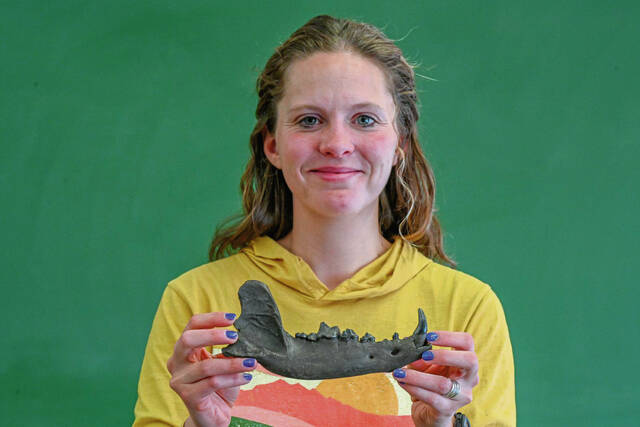Forget 'Game of Thrones,' Freeport divers find their own Dire Wolf
The Cooper River in South Carolina is not for the faint-hearted scuba diver. Prehistoric treasures stud the riverbeds below alligators and other wild creatures in this ecologically rich area where the river meets ocean water and the tannins from decaying vegetation turn the water black.
But it is a favorite destination of Josh and Jennifer Dillaman of Freeport who, last year, found a relatively intact dire wolf jawbone, which is on display at their business, Scott’s Scuba Service in Freeport.
The extinct pack predator experienced a surge of popularity as they were very much alive in the HBO medieval fantasy series “Game of Thrones.”
Dire wolves, about 50% larger than modern-day wolves, lived 250,000 to 13,000 years ago, during the Ice Age, according to the Carnegie Museum of Natural History. The Carnegie’s collection includes a re-creation of the extinct wolf.
The Dillamans’ dire wolf find and other discoveries, including an Ice Age spear tip from 7,000 B.C. and many megalodon shark teeth, have inspired the couple to offer a popular fossil diving class in the Cooper River to hunt for prehistoric treasures. The course, which includes preparation classes in the region, is in its second year and is scheduled again for May. The couple, who secure a permit from the state to collect the Cooper River fossils, visits the river six to seven times a year.
The Cooper River is where divers hunt for the fist-size teeth of prehistoric megalodon sharks, which measured up to 60 feet in length. The colossal predators swam the seas from about 17 million years ago until almost 3 million years ago, according to National Geographic.
Jennifer Dillaman’s fascination is palpable when she recalls her prehistoric finds in the Cooper, a tidal river with a gravel bed rich with fossils. The current regularly carves out the river bank, releasing fossils into the gravel-lined riverbeds. The river cuts through millions of years of fossil beds where prehistoric sharks fed and shed teeth, she said.
The current is so strong that Dillaman and other divers have to lodge a pick into the river bottom to stay in place. Then there’s the dark water that only allows divers to search in small sections with powerful lights.
“The darkness is a mental game,” Dillaman said. “You have to get yourself to go down where you don’t see anything. You can’t even see the tips of your fins.”
The other challenge is dealing with the critters, including alligators, stingrays, freshwater eels, crabs, giant catfish and gar.
“You have to pay attention to where you are at,” Dillaman said. “Alligators are surface predators, so you don’t want to stay on the surface. You want to be under the water.”
Last year, while scanning a small patch of the river bottom, Dillaman spotted an irregularly shaped object. She plucked it from the river bottom and shook off the gravel.
“I saw all these teeth and got very excited,” she said. “You can find single teeth, but finding a jawbone is rare. I made lots of excited noises underwater.”
Dave Cicimurri, curator of natural history for the South Carolina State Museum, confirmed Dillaman’s find in February 2022. He noted in his letter to Dillaman that the jawbone is complete and it is a great find. He also asked if he could take a cast of it.
John Wible, the curator of mammals and a paleontologist at the Carnegie Museum of Natural History, said, after viewing Dillaman’s photos, that her dire wolf jaw is “so thick and robust, it shows how powerful this animal was.”
Wible could detect the size of the wolf’s muscles by the shape of the jawbone. Given the power, strength and legend of the dire wolf, it’s not a surprise that the public’s interest was stoked by the “Games of Thrones” series, he said.
“There are quite a few dire wolf specimens at museums around the country,” he said.
The dire wolf is known mostly in North America with a few specimens found in China, he said. The wolf’s Western subspecies is named after a former Carnegie curator, John Guilday. A subspecies is a population that is different enough for special identification. The Western dire wolf is a little smaller in stature with smaller teeth than its Eastern counterpart, Wible said.
He speculates the dire wolf’s behavior would have been similar to modern wolves. It is in the dog family but more robust than the modern wolf, he said. “For humans, they would have been something to fear.”
The Carnegie, as well as other institutions, secured their wolf casts and re-creations from bones excavated from the La Brea Tar Pits in Los Angeles, which is home to mammoths, mastodons and other prehistoric creatures.
The Carnegie also has dire wolf parts taken from the Frankstown cave in Blair County, which offered a trove of fossils from about 250,000 years ago to 5,000 years ago during the Pleistocene epoch, Wible said. Fossils from the cave first were collected during a Carnegie expedition in 1907.
The Pleistocene was interesting because giant mammals, or megafauna, roamed the earth, including dire wolves, giant lions and saber-toothed cats, Wible said.
“At some point, humans came on the scene at the end of the Pleistocene,” he said. “The megafauna started to go extinct, and we are not sure why.”
Editor’s note: This story was changed to show a more accurate time period for when dire wolves lived.
Remove the ads from your TribLIVE reading experience but still support the journalists who create the content with TribLIVE Ad-Free.



